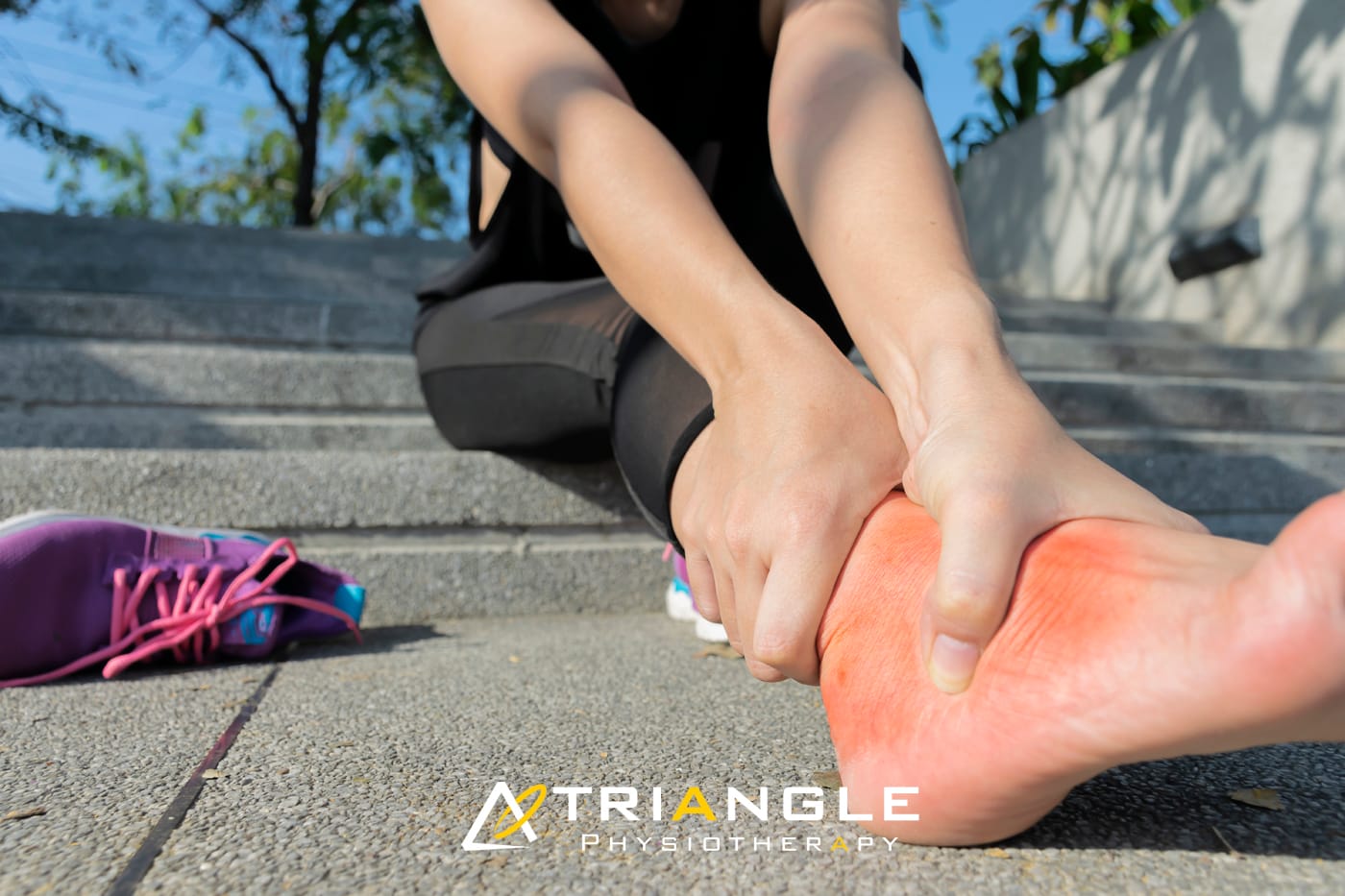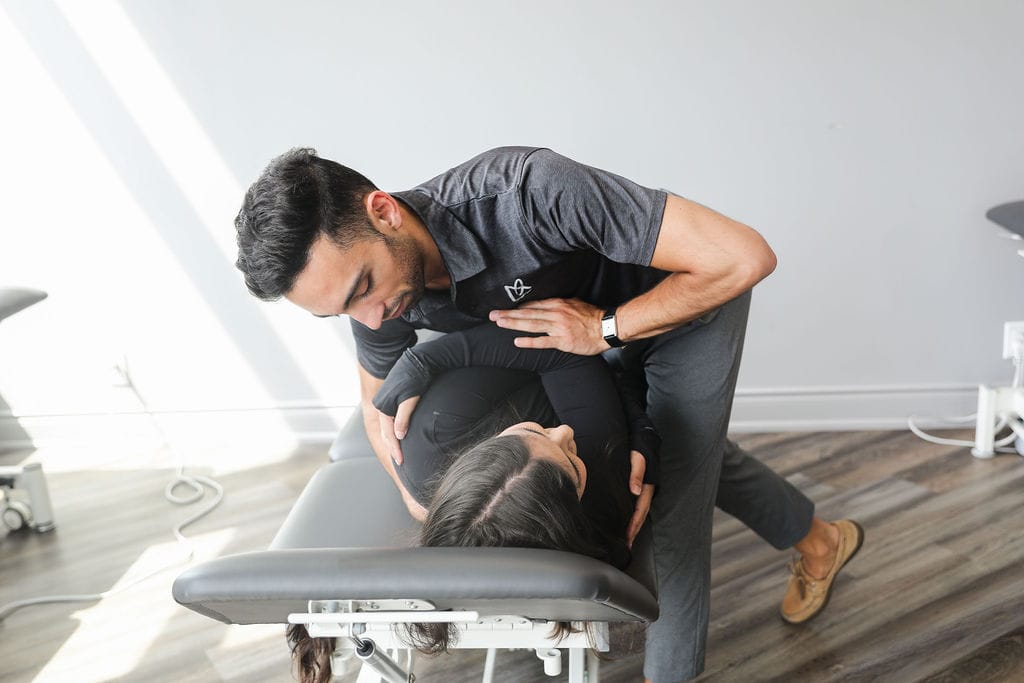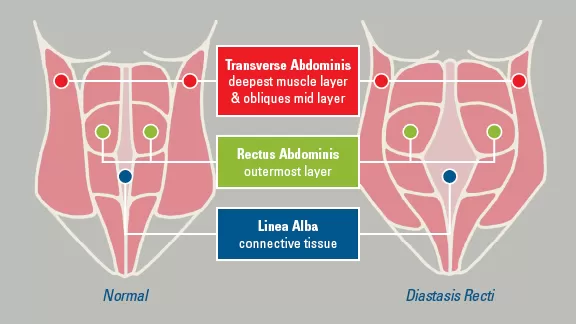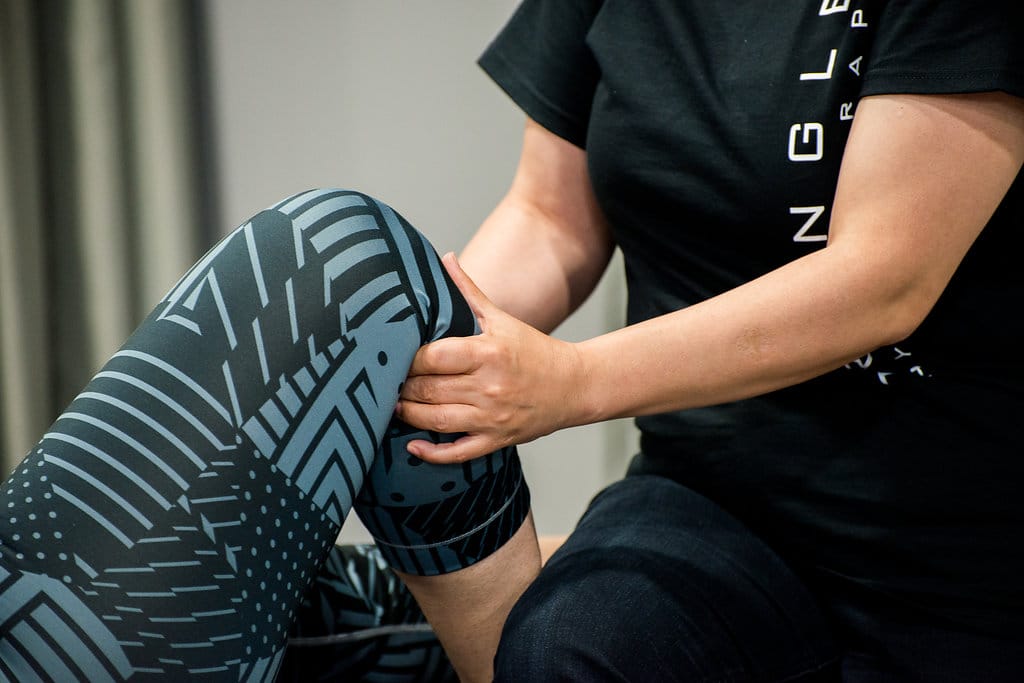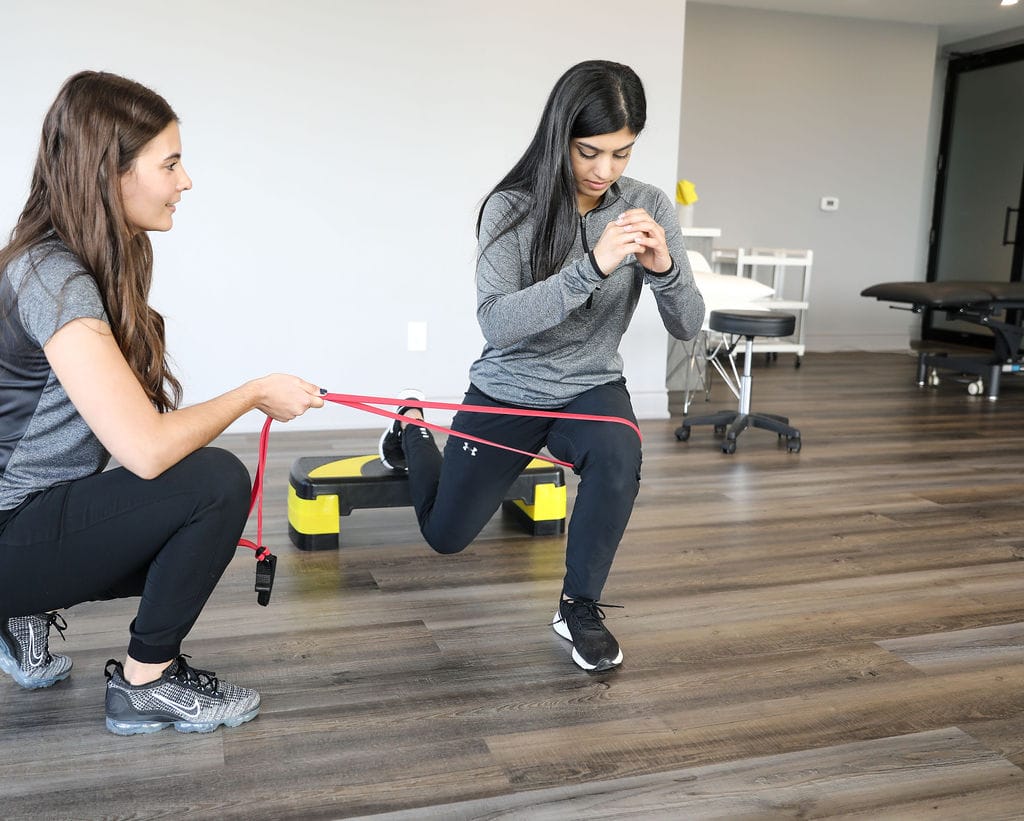Ankle pain can be a major hindrance to our daily activities, making it difficult to walk, run, or even stand for extended periods. Whether it’s due to an injury, chronic condition, or overuse, finding effective solutions to alleviate ankle pain is crucial for restoring mobility and strength. In this article, we will explore some expert tips on effective physiotherapy exercises for ankle pain, aiming to not only relieve discomfort but also enhance the overall function of your ankle. So, if you’re looking for ways to regain control over your ankle health, keep reading to discover these useful exercises and start your journey towards pain-free movement.
Understanding Ankle Pain: Causes and Symptoms
Ankle pain can be a debilitating condition that affects individuals of all ages, from young athletes to the elderly. Understanding the causes and symptoms of ankle pain is crucial in order to find relief and prevent further injury.
The symptoms of ankle pain can vary depending on the underlying cause. Common symptoms include swelling, tenderness, and stiffness. Individuals may also experience difficulty walking or bearing weight on the affected ankle. In some cases, ankle pain can be accompanied by bruising or a visible deformity.
Understanding the causes and symptoms of ankle pain is the first step towards finding relief and restoring functionality. By seeking proper diagnosis and following the guidance of healthcare professionals, individuals can benefit from effective physiotherapy exercises for ankle pain.

Importance of Physiotherapy in Ankle Pain Management
Physiotherapy plays a crucial role in the management of ankle pain. With the help of effective physiotherapy exercises specifically tailored to target the ankle, individuals can experience improvements in pain.
A key aspect of physiotherapy for ankle pain is restoring mobility. Through a range of exercises and techniques, physiotherapists work to increase the flexibility and motion of the ankle joint. These exercises may include stretching, range of motion exercises, and manual therapy techniques.
In addition to mobility, physiotherapy also focuses on enhancing the strength of the ankle muscles. Strengthening exercises, such as calf raises, ankle circles, and resistance band exercises, are often prescribed to improve the stability and support around the ankle joint. Stronger muscles can effectively help in absorbing shock and preventing further injuries.
Key Principles of Physiotherapy Exercises for Ankle Pain Relief
Physiotherapy exercises play a crucial role in providing relief from ankle pain. By incorporating specific exercises into a comprehensive treatment plan, individuals can restore mobility and strengthen their ankles, ultimately alleviating pain and preventing future injuries.
One key principle of effective physiotherapy exercises for ankle pain relief is restoring flexibility. Gentle stretches and range-of-motion exercises can help increase the flexibility of the ankle joint, which in turn improves overall joint function. Flexibility exercises may include ankle circles, toe curls, and calf stretches.
Additionally, proprioception exercises are integral to the rehabilitation process. Proprioception refers to the body’s ability to perceive its position in space. After an ankle injury, this sense may be disrupted, leading to balance issues and an increased risk of falls. Incorporating exercises that challenge balance and proprioception, such as standing on one foot or using a wobble board, can greatly improve overall stability and reduce ankle pain.
Strengthening Exercises for Ankle Stability and Support

If you’re someone who has experienced ankle pain or instability, you understand the importance of having strong and stable ankles. Whether you’re an athlete or simply want to prevent injuries, implementing effective physiotherapy exercises for ankle pain is essential for restoring mobility and strength.
One of the most effective exercises for improving ankle stability is the single-leg balance. This exercise involves standing on one leg and maintaining your balance for a set amount of time. Not only does this exercise strengthen the muscles surrounding your ankle, but it also improves proprioception, which is your body’s ability to sense its position in space. By practicing this exercise regularly, you can enhance your ankle stability and prevent future injuries.
Lastly, calf raises are a great exercise to target the muscles in your lower leg, including those surrounding your ankle. Stand with your feet hip-width apart and lift your heels off the ground as high as possible, then slowly lower them back down. This exercise specifically targets the gastrocnemius and soleus muscles, which play a significant role in ankle stability and support.
Neuromuscular Exercises for Pain Management and Prevention

Neuromuscular exercises are gaining popularity in the field of pain management and prevention. These exercises focus on strengthening the connection between the nervous system and the muscles, helping to alleviate pain and improve overall mobility. One area where these exercises have shown promise is in the treatment of ankle pain.
Effective physiotherapy exercises for ankle pain involve restoring mobility and strength to the affected area. These exercises may include ankle stretches, balance training, and resistance exercises. The goal is to target the specific muscles and ligaments surrounding the ankle joint, improving stability and range of motion.
Another exercise that can be beneficial is heel raises. This exercise involves standing on the edge of a step or curb and raising your heels as high as possible. This works the muscles in your calves, which can help support and stabilize the ankle joint.
Resistance band exercises are also effective in strengthening the ankle. These exercises involve using a resistance band to provide resistance during ankle movements, such as flexion, extension, inversion, and eversion. These movements help to target and strengthen the muscles that support the ankle joint.
Progressive Resistance Training for Ankle Strength and Functionality
Progressive resistance training is a highly beneficial approach for improving ankle strength and functionality. Whether you’re recovering from an injury or simply looking to enhance your athletic performance, incorporating effective physiotherapy exercises for ankle pain is crucial for restoring mobility and strength.
One of the most effective exercises for ankle strength is the calf raise. This exercise targets the muscles in the calves and ankles, helping to build strength and stability. Begin by standing with your feet hip-width apart, and then slowly rise onto the balls of your feet. Hold this position for a few seconds before slowly lowering your heels back down. To intensify the exercise, try performing it on a step, allowing your heels to drop below the level of the step before rising back up.
Another great exercise for ankle strength is the ankle dorsiflexion exercise. This exercise focuses on strengthening the muscles that enable you to flex your ankles upwards. Sit on a chair with your feet flat on the ground and place a resistance band around the ball of your foot. While keeping your heel on the ground, slowly pull your toes towards you against the resistance of the band. Hold for a few seconds and then release. Repeat this movement for several repetitions, gradually increasing the resistance as you progress.
Additionally, incorporating balance and proprioception exercises into your progressive resistance training routine can further enhance ankle strength and functionality. Exercises like single-leg stance or standing on an unstable surface, such as a balance board or foam pad, can help improve your body’s awareness of its position in space and challenge the stabilizing muscles around the ankle.
Incorporating Stretching and Flexibility Exercises in Your Routine
Incorporating stretching and flexibility exercises into your daily routine is essential not only for athletes but for anyone looking to improve their overall fitness and well-being.
The first step towards addressing ankle pain and improving flexibility is to consult with a physiotherapist who can assess your specific needs and design a personalized exercise plan. Common exercises used in physiotherapy for ankle pain include calf stretches, ankle rotations, and plantar fascia stretches. These exercises target the muscles and ligaments surrounding the ankle, increasing flexibility and reducing pain.
Tips for Safely Performing Physiotherapy Exercises for Ankle Pain
If you’re suffering from ankle pain and looking for effective ways to restore mobility and strength, physiotherapy exercises can be extremely beneficial. However, it’s important to approach these exercises with caution and prioritize safety to avoid further injury. Here are some tips to help you safely perform physiotherapy exercises for ankle pain.
First and foremost, always consult a professional physiotherapist before starting any exercise routine. They can assess your condition and recommend specific exercises that are best suited for your individual needs. This will ensure that you’re performing the right exercises and avoiding any that may exacerbate your pain.
It’s crucial to start slow and gradually progress as your ankle gains strength and flexibility. Avoid pushing yourself too hard or performing exercises that cause excessive pain. Remember to listen to your body and give it time to heal. Taking breaks in between exercises and giving yourself time for rest and recovery is equally important.
Conclusion
Don’t let these physical conditions ever ride on you. You can consult any of our locations of Triangle Physiotherapy or simply Book An Appointment online.
Ankle rehabilitation through physiotherapy involves a systematic approach to regaining strength, flexibility, stability, and functionality after an ankle injury. Here’s a step-by-step guide:
Ankle Anatomy and Injury Overview
Ankles are complex joints that connect the lower leg bones (the tibia and fibula) to the foot bones (the talus and calcaneus). The anatomy of the ankle includes bones, ligaments, tendons, and muscles, all of which work together to provide stability, support, and mobility.
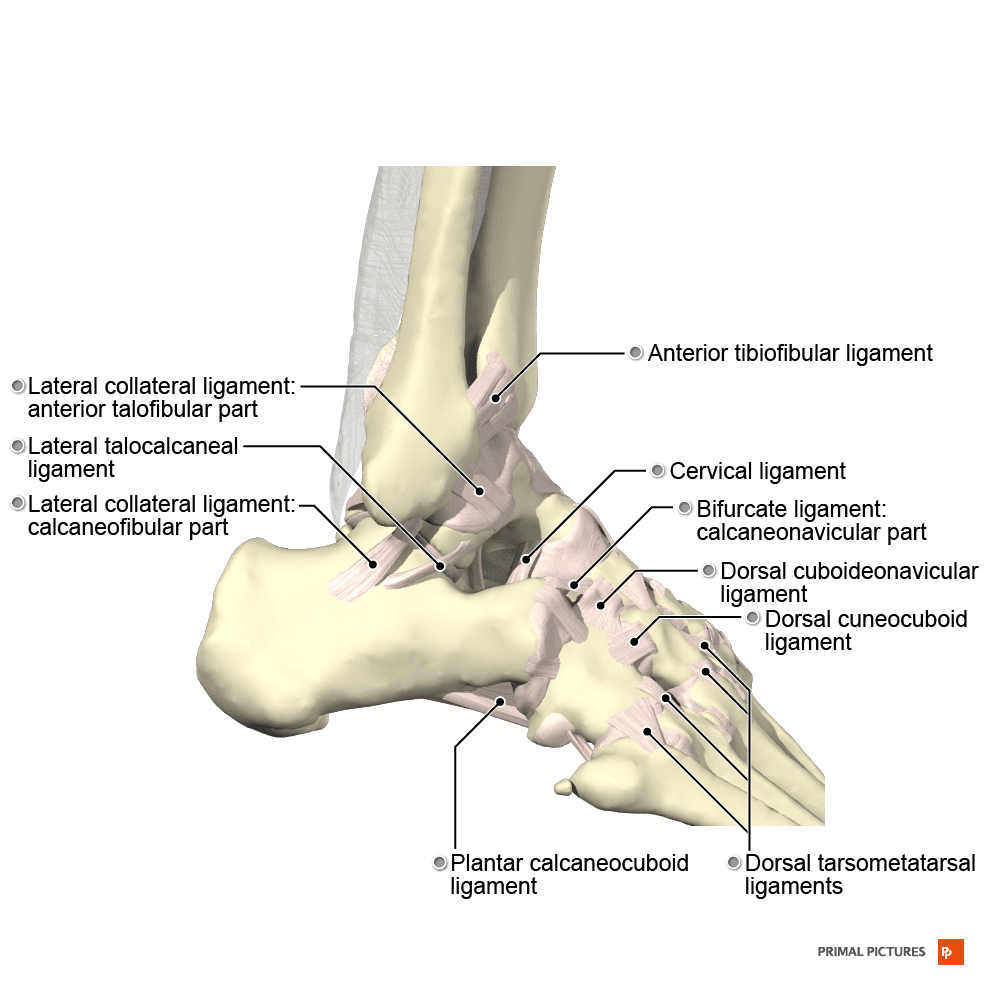
Common Ankle Injuries
- Sprains: Ankle sprains occur when the ligaments are stretched or torn, usually due to an inversion or eversion injury. Lateral ankle sprains, involving the ligaments on the outside of the ankle, are more common than medial ankle sprains.
- Fractures: Fractures can occur in any of the ankle bones, typically as a result of trauma or excessive force. The lateral malleolus (part of the fibula) and the medial malleolus (part of the tibia) are commonly fractured in ankle injuries.
- Achilles Tendon Rupture: This injury involves a tear or rupture of the Achilles tendon, often occurring during activities that involve sudden forceful plantarflexion of the foot.
- Tendinitis: Inflammation of the tendons around the ankle, such as the Achilles tendon or the peroneal tendons, can result from overuse, improper footwear, or biomechanical issues.
Why Physiotherapy for Ankle Rehabilitation?
Physiotherapy is a crucial component of ankle rehabilitation for several reasons:
- Expert Assessment: Physiotherapists are trained to assess musculoskeletal conditions and movement dysfunctions. They can accurately diagnose the extent and nature of the ankle injury, identifying specific impairments and deficits that need to be addressed.
- Individualized Treatment Plans: Physiotherapists develop personalized treatment plans tailored to each patient’s needs, considering factors such as the severity of the injury, functional limitations, and personal goals. This ensures that rehabilitation is targeted and effective.
- Pain Management: Ankle injuries often result in pain and inflammation. Physiotherapists employ various modalities and techniques to manage pain, such as manual therapy, modalities like ultrasound or electrical stimulation, and therapeutic exercises designed to alleviate discomfort.
- Restoration of Function: Physiotherapy aims to restore optimal function to the ankle joint. Therapists use a combination of exercises, manual therapy, and functional activities to improve range of motion, strength, flexibility, and proprioception.
- Prevention of Complications: Without proper rehabilitation, ankle injuries can lead to complications such as chronic pain, stiffness, weakness, instability, and increased risk of re-injury. Physiotherapy helps prevent these complications by promoting optimal healing and restoring normal function.
- Optimizing Recovery Time: Physiotherapy can expedite the recovery process by facilitating tissue healing, reducing swelling, and promoting efficient movement patterns. This can help patients return to their normal activities, work, and sports sooner than if they were to rely solely on rest and self-management.
- Education and Empowerment: Physiotherapists educate patients about their injury, rehabilitation process, and strategies for injury prevention. By understanding their condition and how to manage it, patients feel empowered to take an active role in their recovery and make informed decisions about their health.
- Customized Rehabilitation Programs: Physiotherapists design comprehensive rehabilitation programs that evolve as the patient progresses. These programs include a combination of therapeutic exercises, manual therapy, modalities, and functional training tailored to address the specific needs and goals of the individual.
- Coordination of Care: Physiotherapists often work closely with other healthcare professionals, such as orthopedic surgeons, sports medicine physicians, and athletic trainers, to ensure comprehensive and coordinated care for the patient. This multidisciplinary approach optimizes outcomes and promotes continuity of care.
Step-by-Step Ankle Rehabilitation Through Physiotherapy
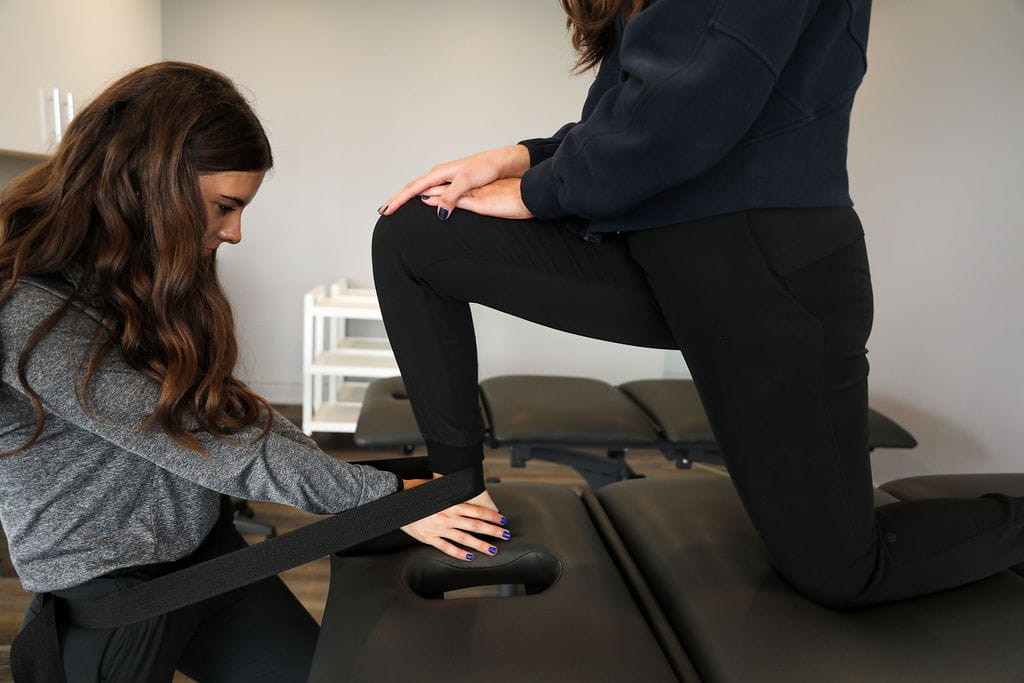
Step 1: Initial Assessment
Our physiotherapist will conduct a thorough assessment of your condition, including a detailed medical history review and a physical examination. This step helps us understand your specific concerns and develop an appropriate treatment plan.
Step 2: Pain Management
Physiotherapy plays a significant role in pain management through various techniques and modalities tailored to each individual’s needs.
Pain management techniques that may be used in your rehabilitation are:
- Heat/Cold Therapy
- Manual Therapy
- Electrotherapy
- Education and self-management strategies
- Activity modification
Step 3: Range of Motion Exercises
Step 4: Strengthening Exercises
Step 5: Balance and Proprioception
Step 6: Education and Prevention
Click here to book an appointment with a physiotherapist at one of our eight locations.
- Physiotherapy Etobicoke – Triangle Physiotherapy Etobicoke
- Oakville Physiotherapy Clinic – Triangle Physiotherapy Oakville
- Physiotherapy North York – Triangle Physiotherapy North York
- Mississauga Physiotherapy Clinics – Triangle Physiotherapy Mississauga
- Downtown Physiotherapy Clinics – Triangle Physiotherapy King West
- Uptown Physiotherapy Clinics – Triangle Physiotherapy Lawrence Park
- Physiotherapy Clinic Downtown Toronto – Triangle Physiotherapy Queens Quay
- Physiotherapy Clinics Mississauga – Triangle Physiotherapy Erin Mills
Vertigo is a common vestibular disorder characterized by a sensation of spinning or dizziness, often accompanied by nausea, sweating, and balance problems. It can significantly impact daily life and lead to falls and injuries if not properly managed. While vertigo can have various underlying causes, including inner ear issues, vestibular migraines, and neurological conditions, physiotherapy can play a crucial role in managing symptoms and improving balance. In this article, we’ll explore some effective physiotherapy tips for individuals dealing with vertigo and how these exercises can help them regain their balance and quality of life.
Understanding Vertigo
Vertigo is a symptom rather than a condition itself and is often caused by disturbances in the inner ear or the vestibular system, which controls balance and spatial orientation. Common causes of vertigo include benign paroxysmal positional vertigo (BPPV), vestibular neuritis, Meniere’s disease, and vestibular migraines. Symptoms of vertigo can vary in severity and duration, ranging from mild, intermittent episodes to constant and debilitating dizziness. Vertigo signs such as dizziness, nausea, and imbalance can significantly affect daily activities and quality of life.
Physiotherapy for Vertigo
Physiotherapy for vertigo, known as Vestibular Rehabilitation Therapy (VRT), focuses on exercises and techniques to improve balance, reduce dizziness, and enhance vestibular function.
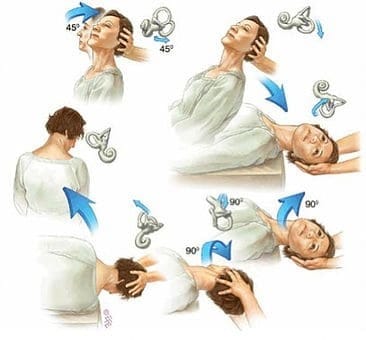
Vestibular Rehabilitation Therapy (VRT)
VRT is a specialized form of physiotherapy designed to improve balance and reduce vertigo symptoms through targeted exercises and maneuvers.
These exercises aim to promote adaptation and compensation within the vestibular system, helping the brain adjust to changes in balance and spatial orientation.
Common VRT exercises include gaze stabilization exercises, balance training, habituation exercises, and sensory integration techniques.
VRT is tailored to each individual’s specific needs and may include the following components:
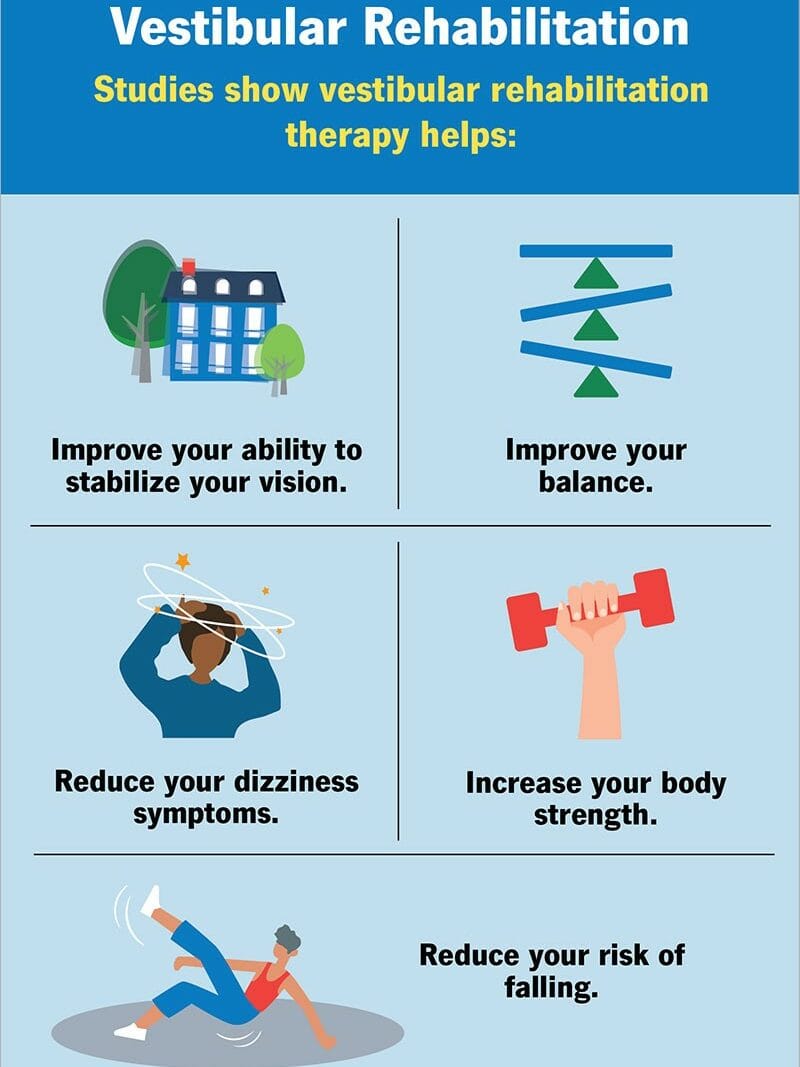
Canalith Repositioning Maneuvers (CRM)
Canalith repositioning maneuvers, such as the Epley maneuver for BPPV, are effective in treating certain types of vertigo caused by displaced calcium crystals in the inner ear.
A trained and qualified physiotherapist can perform these maneuvers to help reposition the crystals and alleviate symptoms of dizziness and spinning.
Gaze Stabilization Exercises
Gaze stabilization exercises aim to improve visual focus and stability during head movements, which can help reduce dizziness and improve balance.
Examples of gaze stabilization exercises include tracking moving objects with the eyes or performing head movements while maintaining focus on a stationary target.
Balance Training
Balance training exercises help improve stability and reduce the risk of falls in individuals with vertigo.
These physiotherapy exercises for vertigo focus on improving proprioception, coordination, and postural control through activities such as standing on one leg, walking in tandem, and using balance boards or stability balls.
A physiotherapist can provide personalized balance training exercises tailored to the individual’s specific needs and level of impairment.
Vestibular Habituation Exercises
Habituation exercises involve gradually exposing individuals to movements or stimuli that provoke vertigo symptoms in a controlled manner.
Over time, repeated exposure helps desensitize the vestibular system and reduce the intensity and frequency of vertigo episodes.
Examples of habituation exercises include head movements, visual tracking exercises, and simulated motion activities.
Lifestyle Modifications
In addition to physiotherapy interventions, certain lifestyle modifications can help manage vertigo symptoms and improve overall quality of life. These may include avoiding triggers such as sudden head movements or excessive visual stimuli, practicing stress management techniques, staying hydrated, and maintaining a healthy diet and sleep routine.
Physical therapy, specifically vestibular rehabilitation therapy, offers valuable tools and techniques for individuals struggling with vertigo. By addressing underlying vestibular dysfunction and improving balance and stability, physical therapists empower individuals to regain their independence and confidence in daily activities. If you’re experiencing vertigo symptoms, consider consulting with a physical therapist trained in vestibular rehabilitation to develop a personalized treatment plan tailored to your needs. With the right guidance and support, relief from vertigo is within reach, allowing you to find your balance and reclaim your life.
Click here to book an appointment with a physiotherapist at one of our eight locations
- Physiotherapy Etobicoke – Triangle Physiotherapy Etobicoke
- Oakville Physiotherapy Clinic – Triangle Physiotherapy Oakville
- Physiotherapy North York – Triangle Physiotherapy North York
- Mississauga Physiotherapy Clinics – Triangle Physiotherapy Mississauga
- Downtown Physiotherapy Clinics – Triangle Physiotherapy King West
- Uptown Physiotherapy Clinics – Triangle Physiotherapy Lawrence Park
- Physiotherapy Clinic Downtown Toronto – Triangle Physiotherapy Queens Quay
- Physiotherapy Clinics Mississauga – Triangle Physiotherapy Erin Mills
What is Sciatica?
Sciatica is a term used to describe a condition that affects the sciatic nerve in the leg. The client generally experiences pain and/or tingling, and numbness along the course of the nerve. This condition typically initiates in the lower back and the symptoms travel down the leg. The sciatic nerve originates by union of several nerve roots in the lower back and forms the largest nerve in the body. The sciatic nerve then passes through bony tunnels and various muscles which are compactly arranged and terminates in the knee. If the nerve gets irritated anywhere during this course, it may lead to Sciatica. The other most common cause is a ruptured intervertebral disc which may press on the nerve.
What are the symptoms of Sciatica?
- Pain – begins in the lower back and proceeds along the length of the nerve. It can be mild/sharp/excruciating. It may be constant or at intervals.
- Tingling &/or numbness- also along the length of the nerve.
- Muscle weakness may be present in the leg or the foot.
- Affected by posture
What are the causes of Sciatica?
Some of the most common causes of sciatica are:
- Herniated disc
- Degeneration of lumbar spine
- Spinal stenosis
- Trauma or fracture to the spine
- Irritation of sacroiliac joint
- Piriformis syndrome
- Muscle tightness such as that of the hamstring
What are the 7 best exercises for Sciatica?
Some of the most effective exercises for sciatica are:
- Pelvic Tilts: Lie on your back with knees bent and feet flat on the floor. Tighten your abdominal muscles and tilt your pelvis upward slightly, flattening your back against the floor. Hold for a few seconds, then release. Repeat several times.
- Piriformis Stretch: Sit on a chair with feet flat on the floor. Cross the affected leg over the opposite knee, then gently lean forward while keeping your back straight. Hold the stretch for 15-30 seconds and repeat on the other side.
- Hamstring Stretch: Lie on your back with one leg bent and the other extended straight up. Hold the back of your thigh of the straight leg with both hands and gently pull it towards your chest until you feel a stretch in the hamstring. Hold for 15-30 seconds and switch legs.
- Seated Spinal Twist: Sit on the floor with legs extended in front of you. Bend one knee and place the foot on the outside of the opposite knee. Twist your torso towards the bent knee, placing the opposite elbow on the outside of the bent knee. Hold for 15-30 seconds and switch sides.
- Child’s Pose: Start on your hands and knees, then sit back on your heels while reaching your arms forward on the ground. Hold the stretch, feeling the elongation in your spine and lower back. Hold for 15-30 seconds and repeat as needed.
- Cat-Cow Stretch: Start on your hands and knees in a tabletop position. Inhale, arching your back and lifting your head and tailbone towards the ceiling (Cow Pose). Exhale, rounding your back and tucking your chin to your chest (Cat Pose). Repeat for several breaths.
- Bridging: Lie on your back with knees bent and feet flat on the floor. Engage your core and glutes as you lift your hips towards the ceiling, creating a straight line from shoulders to knees. Hold for a few seconds, then lower back down. Repeat for several repetitions.
How do I book an appointment at a Triangle Physiotherapy Clinic near me?
Click HERE to book an appointment with a physiotherapist at one of our eight locations.
- Physiotherapy Etobicoke – Triangle Physiotherapy Etobicoke
- Oakville Physiotherapy Clinic – Triangle Physiotherapy Oakville
- Physiotherapy North York – Triangle Physiotherapy North York
- Mississauga Physiotherapy Clinics – Triangle Physiotherapy Mississauga
- Downtown Physiotherapy Clinics – Triangle Physiotherapy King West
- Uptown Physiotherapy Clinics – Triangle Physiotherapy Lawrence Park
- Physiotherapy Clinic Downtown Toronto – Triangle Physiotherapy Queens Quay
- Physiotherapy Clinics Mississauga – Triangle Physiotherapy Erin Mills
What is the difference between a physiotherapist, massage therapist, and chiropractor?
Which practitioner is the best to see?
This is one of the most common questions that we get asked! Let’s dive in and learn more about how each of these practitioners can make a difference to your health.
What are the similarities between physiotherapists, massage therapists, and chiropractors?
- They treat musculoskeletal conditions – soft tissue (muscles, ligaments, tendons), bones, or the nervous system.
- All three are regulated professions – you cannot call yourself an RMT, chiropractor, or physiotherapist unless you are registered with their regulatory College.
- They all have specialized training – Physiotherapists at a recognized university, Chiropractors at a recognized Chiropractic College, and RMTs at a recognized Massage therapy course.
- All three have to pass exams administered by their regulatory board.
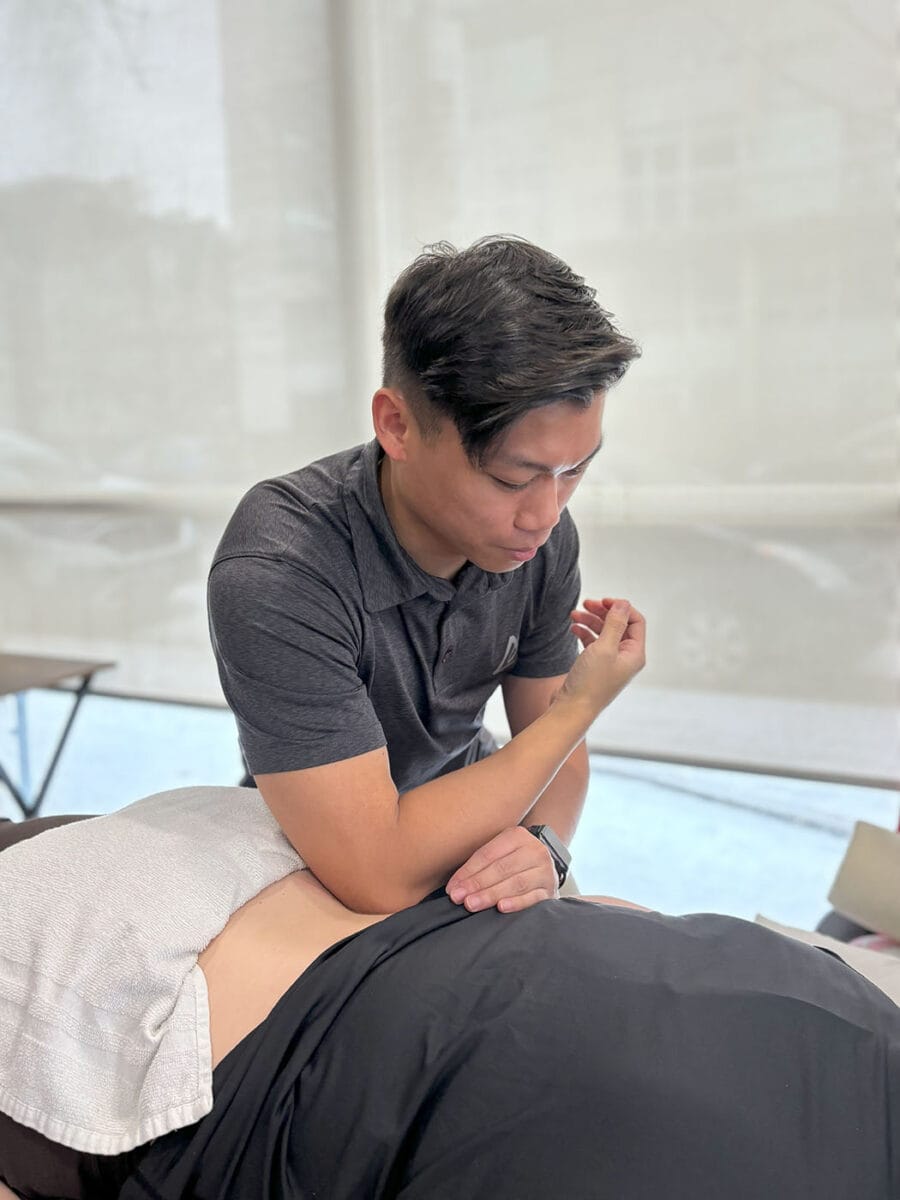
What does a Chiropractor do?
Chiropractic is a licensed healthcare profession that emphasizes the body’s ability to heal itself. Treatment typically involves manual therapy, often including spinal manipulation which helps restore joint function.
What does an RMT do?
An RMT, or Registered Massage Therapist, is a licensed healthcare professional who specializes in providing therapeutic massage treatments. They are trained to assess and treat various musculoskeletal conditions and injuries using hands-on techniques to manipulate muscles, tendons, ligaments, and other soft tissues of the body.
What does a physiotherapist do?
You should consider seeing a physiotherapist when you’re experiencing pain or discomfort, or have mobility issues that affect your daily activities and quality of life. Physiotherapists are healthcare professionals trained to diagnose and treat a wide range of musculoskeletal and movement-related conditions. They can also help with vestibular rehabilitation and pelvic health issues.
Physiotherapists can look at alignment but they also test joint mobility, muscle strength, muscle flexibility, nerve function, posture, and movement patterns. They restore movement and improve pain predominantly through exercise rehabilitation, postural re-training, and lifestyle advice, but also use hands-on techniques.
Can I see all three of these practitioners?
Absolutely! All three practitioners work collaboratively to get you the best possible outcomes and help you reach your health goals.
How do I book an appointment at a Triangle Physiotherapy Clinic near me?
Click HERE to book an appointment with a physiotherapist, RMT or chiropractor at one of our eight locations.
- Physiotherapy Etobicoke – Triangle Physiotherapy Etobicoke
- Oakville Physiotherapy Clinic – Triangle Physiotherapy Oakville
- Physiotherapy North York – Triangle Physiotherapy North York
- Mississauga Physiotherapy Clinics – Triangle Physiotherapy Mississauga
- Downtown Physiotherapy Clinics – Triangle Physiotherapy King West
- Uptown Physiotherapy Clinics – Triangle Physiotherapy Lawrence Park
- Physiotherapy Clinic Downtown Toronto – Triangle Physiotherapy Queens Quay
- Physiotherapy Clinics Mississauga – Triangle Physiotherapy Erin Mills
What is Diastasis Recti?
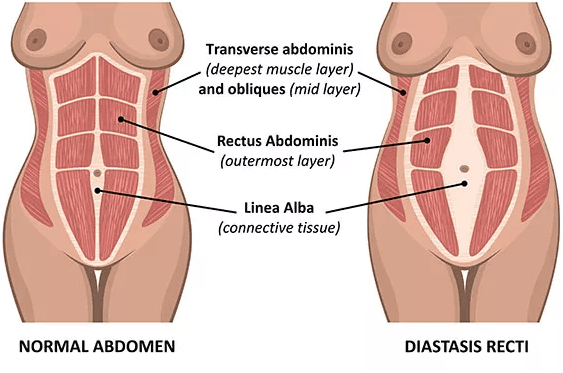
Diastasis recti is a condition where the right and left sides of the rectus abdominis (the “six-pack” muscles) separate, causing a gap in the abdominal wall. This condition is relatively common, especially among pregnant women and newborns, but it can affect individuals of any age or gender.
What are the causes of Diastasis Recti?
Diastasis recti often occurs during pregnancy due to the expanding uterus putting pressure on the abdominal muscles. It can also result from rapid weight gain or loss, improper lifting techniques, excessive abdominal exercises, or genetics.
What are the symptoms of Diastasis Recti?
The most noticeable symptom of diastasis recti is a visible bulge or ridge running down the midline of the abdomen, particularly noticeable when the person tries to sit up or strain. Other symptoms may include lower back pain, poor posture, and difficulty with core strength and stability.
How can it be treated?
Treatment options for diastasis recti may include physical therapy exercises to strengthen the abdominal muscles, wearing an abdominal binder or splint to provide support, and in severe cases, surgery to repair the separated muscles. It’s essential to consult a physiotherapist for personalized advice on treatment options.
Diastasis recti commonly occurs during pregnancy and may persist postpartum. Women who experience diastasis recti after childbirth should consult with a physiotherapist for guidance on safe exercises and techniques to promote healing and recovery.
Where can I find a pelvic health physiotherapist in Mississauga?
We have 8 locations with pelvic health physiotherapists to help you.
- Pelvic Health Physiotherapy Etobicoke – Triangle Physiotherapy Etobicoke
- Oakville Pelvic Health – Triangle Physiotherapy Oakville
- Pelvic Health Physiotherapy North York – Triangle Physiotherapy North York
- Mississauga Pelvic Health – Triangle Physiotherapy Mississauga
- Downtown Pelvic Health – Triangle Physiotherapy King West
- Uptown Toronto Pelvic Health – Triangle Physiotherapy Lawrence Park
- Pelvic Physiotherapy Downtown Toronto – Triangle Physiotherapy Queens Quay
- Mississauga Pelvic Health – Triangle Physiotherapy Erin Mills
Gardening is a deeply rewarding hobby, but for many enthusiasts, it can also be a source of physical discomfort and pain. From sore backs to achy knees, the joys of gardening can sometimes be overshadowed by the strain it puts on our bodies. However, with the right techniques and precautions, it’s possible to enjoy gardening without the pain. In this blog post, we’ll explore some helpful tips and tricks to make your gardening experience as enjoyable and pain-free as possible.
Proper Body Mechanics
One of the most important aspects of pain-free gardening is practicing proper body mechanics. This means using correct posture and techniques to minimize strain on your muscles and joints. Here are a few key tips:
- Bend at the knees, not at the waist, when lifting heavy objects such as bags of soil or pots.
- Use ergonomic gardening tools with padded handles to reduce strain on your hands and wrists.
- Take frequent breaks and avoid staying in one position for too long to prevent stiffness and discomfort.
Warm-up
Just like any other physical activity, gardening can benefit from a proper warm-up routine. Before diving into your gardening tasks, take a few minutes to stretch your muscles and loosen up your joints. Simple exercises like arm circles, leg swings, and back stretches can help prepare your body for the work ahead and reduce the risk of injury.
Choose the Right Tools
Investing in the right gardening tools can make a world of difference when it comes to preventing pain and discomfort. Look for tools that are lightweight, ergonomic, and designed to reduce strain on your body. Long-handled tools can help you avoid bending over excessively, while padded kneelers can protect your knees during tasks like planting and weeding.
Break Tasks into Manageable Chunks
Instead of trying to tackle your entire garden in one marathon session, break your gardening tasks into smaller, more manageable chunks. Spread out your work over several days or weeks to give your body time to rest and recover between sessions. Not only will this approach help prevent pain and fatigue, but it will also allow you to enjoy your time in the garden without feeling overwhelmed.
Embrace Container Gardening
If you struggle with mobility issues or have limited space, container gardening can be a fantastic alternative to traditional gardening. By planting in pots and containers, you can bring the joys of gardening right to your doorstep without the need for bending, kneeling, or heavy lifting. Plus, container gardening allows for greater flexibility and creativity in your garden design.

How do I book an appointment with a Physiotherapist near me?
Click HERE to book an appointment with a physiotherapist or chiropractor at one of our eight locations.
- Physiotherapy Etobicoke – Triangle Physiotherapy Etobicoke
- Oakville Physiotherapy Clinic – Triangle Physiotherapy Oakville
- Physiotherapy North York – Triangle Physiotherapy North York
- Mississauga Physiotherapy Clinics – Triangle Physiotherapy Mississauga
- Downtown Physiotherapy Clinics – Triangle Physiotherapy King West
- Uptown Physiotherapy Clinics – Triangle Physiotherapy Lawrence Park
- Physiotherapy Clinic Downtown Toronto – Triangle Physiotherapy Queens Quay
- Physiotherapy Clinics Mississauga – Triangle Physiotherapy Erin Mills
Introduction
Physiotherapy stands as a cornerstone in the realm of healthcare, offering a holistic approach to the maintenance, rehabilitation, and enhancement of physical function. In Oakville, a city renowned for its commitment to health and wellness, physiotherapy emerges as a pivotal service for residents aiming to revitalize their health. This article delves into the profound benefits of physiotherapy in Oakville, highlighting its significance in fostering a community of well-being and vitality.
Understanding Physiotherapy
Physiotherapy, a science-driven profession, employs a variety of techniques and modalities to restore, maintain, and maximize physical strength, function, motion, and overall well-being. The historical roots of physiotherapy trace back centuries, evolving significantly to the comprehensive practice we recognize today.
The Science Behind Physiotherapy
The effectiveness of physiotherapy lies in its evidence-based approach, utilizing an understanding of anatomy, physiology, and the principles of biomechanics. It plays a crucial role in pain management, employing techniques like manual therapy, exercise, and electrotherapy to alleviate discomfort and enhance function.
Benefits of Physiotherapy
The advantages of physiotherapy extend beyond mere injury recovery. It is instrumental in enhancing mobility, managing chronic conditions, improving posture, and even preventing future physical issues. For athletes, physiotherapy is a staple in both recovery and performance enhancement.
Physiotherapy in Oakville: A Closer Look
Oakville’s physiotherapy landscape is distinguished by its quality of care and patient-centric approach. The city is home to leading clinics and therapists dedicated to providing tailored treatments that address individual health goals and concerns.
Specialized Physiotherapy Services in Oakville
Recognizing the diverse needs of its community, Oakville offers specialized physiotherapy services catering to various demographics, including children, the elderly, athletes, and individuals with neurological conditions, ensuring comprehensive care for all.
Integrating Physiotherapy into Your Wellness Routine
Physiotherapy should not be viewed as a last resort for injury or illness but as a proactive measure in maintaining optimal health. Understanding when and how to incorporate physiotherapy into your life can significantly enhance your overall wellness.
Choosing the Right Physiotherapist
The key to a successful physiotherapy experience lies in selecting the right practitioner. Factors such as qualifications, specialization, and a patient-centered approach are critical in choosing a therapist that aligns with your health objectives.
Insurance and Physiotherapy in Oakville
Navigating the intricacies of insurance coverage for physiotherapy in oakville residents. Understanding your policy and out-of-pocket expenses can ensure that you make the most of your benefits while seeking treatment.
The Future of Physiotherapy in Oakville
The field of physiotherapy is constantly evolving, with ongoing research and technological advancements shaping its future. Oakville’s commitment to healthcare innovation positions it as a leader in the advancement of physiotherapy practices.
Conclusion
Physiotherapy offers a pathway to enhanced health and wellness, playing a vital role in the lives of Oakville residents. By embracing its benefits and integrating it into our health routines, we can all contribute to a healthier, more vibrant community.
FAQ
How often should I attend physiotherapy sessions?
Frequency depends on your condition and goals. Your therapist will recommend a schedule tailored to your needs.
Can physiotherapy completely cure chronic conditions?
While not all chronic conditions can be cured, physiotherapy can significantly alleviate symptoms and improve quality of life.
What should I wear to my physiotherapy appointments?
Opt for comfortable, loose-fitting clothing that allows easy access to the area being treated and facilitates movement.
How long does it take to see results from physiotherapy?
Results vary depending on the individual and their condition. Some may notice improvements within a few sessions, while others may take longer.
Can children and elderly benefit from physiotherapy?
Absolutely. Physiotherapy offers benefits across all age groups, with specialized programs catering to the unique needs of children and the elderly.
Is physiotherapy only for injury recovery?
No, physiotherapy is also valuable for preventive care, managing chronic conditions, and enhancing overall physical well-being.
What are the risks of not seeking physiotherapy after an injury?
Foregoing physiotherapy can lead to prolonged recovery, decreased functionality, and an increased risk of re-injury.
By embracing the comprehensive benefits of physiotherapy, particularly in a community-focused city like Oakville, we can all take proactive steps towards maintaining and enhancing our health and well-being.
Physiotherapy is a vital part of healthcare that focuses on the physical rehabilitation, injury prevention, and health and wellness of patients. Whether you’re dealing with a chronic condition, recovering from surgery, or looking to improve your physical performance, physiotherapy can offer significant benefits. Here are ten compelling reasons to consider seeing a physiotherapist.
1. Relief from Chronic Pain
Chronic pain, which can arise from various conditions such as arthritis or repetitive strain injuries, can be debilitating. Physiotherapists use a combination of treatments, including exercise, manual therapy, and education about pain management strategies to help alleviate this pain and improve your daily function.
2. Recovery After Surgery
Post-operative care is crucial for a successful recovery, especially after orthopedic surgeries like knee or hip replacements. Physiotherapists design customized rehabilitation programs to help you regain strength, mobility, and function, facilitating a quicker and more effective recovery.
3. Injury Rehabilitation
Physiotherapy is essential for the rehabilitation of injuries, whether they’re sports-related, accidental, or due to everyday activities. Through targeted exercises and therapies, physiotherapists help heal injured tissues, restore function, and prevent further injuries.
4. Support for Aging Adults
Aging can bring about various physical challenges, including joint wear and tear, reduced balance, and decreased strength. Physiotherapy offers strategies and treatments to help older adults maintain their independence, reduce pain, and manage age-related conditions.
5. Treatment for Neurological Disorders
For individuals affected by neurological conditions such as stroke, multiple sclerosis, or Parkinson’s disease, physiotherapy can play a significant role in rehabilitation. It aims to enhance function, improve mobility, and increase independence through personalized therapeutic exercises and techniques.
6. Balance Improvement and Fall Prevention
Balance issues can significantly increase the risk of falls, particularly in older adults. Physiotherapists utilize specific exercises to challenge and improve balance, enhancing stability and reducing the likelihood of falls.
7. Enhancement of Athletic Performance
Athletes at all levels can benefit from physiotherapy, not just for injury treatment but also for performance enhancement. Physiotherapists provide guidance on optimizing strength, flexibility, and technique to improve athletic performance and reduce the risk of sports injuries.
8. Pediatric Care
Children with developmental disorders, congenital conditions, or injuries can achieve better mobility and function through pediatric physiotherapy. Tailored to each child’s needs, this therapy focuses on enhancing movement patterns and addressing developmental challenges.
9. Management of Women’s Health Issues
Physiotherapy addresses specific women’s health concerns, including postnatal recovery, pelvic floor dysfunction, and lymphedema following breast cancer surgery. Specialized physiotherapists offer treatments and exercises to manage these conditions effectively.
10. Assistance with Respiratory Conditions
Physiotherapy also plays a role in managing respiratory conditions like asthma and chronic obstructive pulmonary disease (COPD). Through breathing exercises and techniques to clear mucus from the lungs, physiotherapy can help improve breathing and overall lung function.
Seeking the expertise of a physiotherapist can lead to significant improvements in your health and well-being. Whether you’re dealing with a specific medical condition, recovering from an injury, or simply looking to improve your physical capabilities, physiotherapy offers a wide range of benefits tailored to meet your individual needs.
Frequently Asked Questions
1. What conditions can physiotherapy treat?
Physiotherapy can treat a wide range of conditions including, but not limited to, chronic pain, sports injuries, post-surgical rehabilitation, neurological disorders (like stroke or Parkinson’s disease), respiratory conditions, pediatric conditions, women’s health issues, and age-related mobility problems.
2. Do I need a referral to see a physiotherapist?
In many places, you can see a physiotherapist without a referral (direct access). However, some insurance plans or healthcare systems may require a referral from a doctor for the services to be covered. It’s best to check with your insurance provider or local healthcare regulations.
3. What should I expect during my first physiotherapy appointment?
During your first visit, the physiotherapist will conduct a comprehensive assessment, which includes discussing your medical history, the symptoms you are experiencing, and your treatment goals. They may also perform a physical examination to evaluate your condition further. Based on this assessment, they will develop a personalized treatment plan.
4. How long does a physiotherapy session last?
The duration of a physiotherapy session can vary but typically lasts between 30 to 60 minutes. The length of your session may depend on your specific condition, the treatments involved, and the policies of the physiotherapy clinic.
5. Will physiotherapy treatments hurt?
While physiotherapy aims to relieve pain and improve your condition, some treatments or exercises might cause discomfort, especially when recovering from an injury or surgery. Your physiotherapist will work with you to ensure treatments are manageable and will adjust your therapy plan as needed to keep discomfort to a minimum.
Biking injuries can occur due to various reasons, including accidents, overuse, improper bike setup, or poor riding technique. It’s important to address injuries promptly and seek professional medical advice if needed.

Here are common biking injuries and general tips on how to manage them:
- Sprains and Strains:
- Management: Rest, ice, compression, and elevation (R.I.C.E.) can help alleviate pain and swelling.
- Prevention: Warm up before riding, stretch regularly, and ensure proper bike fit.
- Road Rash:
- Management: Clean the wound thoroughly, apply an antiseptic ointment, and keep it covered with a sterile dressing.
- Prevention: Wear appropriate protective gear, including gloves, long-sleeved shirts, and pants.
- Fractures:
- Management: Seek immediate medical attention. Immobilize the affected area and avoid putting weight on it.
- Prevention: Wear protective gear, including a helmet, and follow proper safety guidelines.
- Cuts and Abrasions:
- Management: Clean the wound with mild soap and water, apply an antiseptic, and cover with a sterile dressing.
- Prevention: Wear protective clothing, such as long sleeves and pants, and use gloves.
- Overuse Injuries:
- Management: Rest, ice, and anti-inflammatory medications can help. Physical therapy may be beneficial.
- Prevention: Gradually increase your riding intensity and distance, cross-train to strengthen supporting muscles, and maintain a proper bike fit.
- Neck and Back Pain:
- Management: Rest, gentle stretching, and over-the-counter pain medications can provide relief. If persistent, consult a healthcare professional.
- Prevention: Ensure proper bike fit, maintain good posture while riding, and incorporate core-strengthening exercises.
- Nerve Compression (Cyclist’s Palsy):
- Management: Rest, anti-inflammatory medications, and adjusting bike setup. Consult a healthcare professional if symptoms persist.
- Prevention: Change hand positions regularly while riding, wear padded gloves, and maintain a proper bike fit.
- Dehydration and Heat-Related Issues:
- Management: Rehydrate, rest in a cool place, and use electrolyte solutions. Seek medical attention for severe cases.
- Prevention: Stay well-hydrated, wear appropriate clothing, and avoid riding in extreme heat.
Always remember to consult with a healthcare professional for accurate diagnosis and treatment. If in doubt about the severity of an injury, seek medical attention promptly. Additionally, consider taking preventive measures to minimize the risk of injuries during biking activities.
How do I book an appointment with a Physiotherapist near me?
Click HERE to book an appointment with a physiotherapist or chiropractor at one of our eight locations.
- Physiotherapy Etobicoke – Triangle Physiotherapy Etobicoke
- Oakville Physiotherapy Clinic – Triangle Physiotherapy Oakville
- Physiotherapy North York – Triangle Physiotherapy North York
- Mississauga Physiotherapy Clinics – Triangle Physiotherapy Mississauga
- Downtown Physiotherapy Clinics – Triangle Physiotherapy King West
- Uptown Physiotherapy Clinics – Triangle Physiotherapy Lawrence Park
- Physiotherapy Clinic Downtown Toronto – Triangle Physiotherapy Queens Quay
- Physiotherapy Clinics Mississauga – Triangle Physiotherapy Erin Mills

